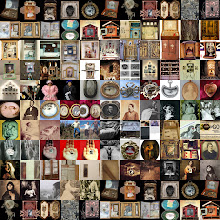
The catalogue from the exhibiton I participated in Madrid, Sexo Im/Explicito is now printed and will be available to view online soon. There's a very interesting text on the representations of Christ's sexuality, by Dr. Vicente Alemany Sanchez-Moscoso and Dr. Jaime Repolles Llaurado. It mentions a 1983 scandalous essay The Sexuality of Christ by Leo Steinberg. According to Steinberg, in renaissance theology and painting, the explicit erect penis in depictions of the crucifixion is proof of Christ's incarnation (divinity embodied in a human body). It underlines the rol of Christ as seed of the whole of Christianity and his significant place in the jewish genealogy.
In my view, it is a clear replacement of the phallus for the vagina, for the underlying origin of Christ's sacrifice simbolism lies in the menstruation. It is the vagina where sons (and daughters) come from, which is substituted by the phallus as signifier of descent. This descent, that values the father-son over the mother and daughter is precisely the basis and founder of Patriarchal order. God's sacrifice of his own son, his own self, turned flesh and blood, to bring redemption and renewal employs menstrual symbolism in the idea of spilling blood as a necessary painful sacrifice of the son/daughter, which is still part of ourselves and our own blood. The masking of this original meaning grounded in the female body explains the use of phallic symbols instead.

Ecce Homo, Maerten vans Heemskerck, 1525.
Miram Garlo, curator of the exhibition, does an overview of western modern art's representation of sexual organs, going through key artworks like Courbet's Origin of the World and ORLAN's response The Origin of War, Duchamp's Etant Donnes, Bourgeois' Fillete, Judy Chicago's Dinner Party or Carolee Schneeman's Interior Scroll. If we look at the representations of vaginas in this brief history, we can clearly distinguish the voyeuristic and erotic male view from the feminist view that turns the passive sex object into a creator of dicourse (in Schneeman's case) and a portrait of herstoric relevance (in Chicago's feminist version of the last supper).
The following two works where my favourites from the exhibition:
Mara Marcos' Juicy Lips, identifying the mouth as a sensual lipped opening where lipstick, playful gestures, kisses and bites create a sense of implicit sexuality. The other, Tessa Doniga's Duality reminds me of some of Ramon Eding's unpublished amazing photographs of people wearing masks in the forest, and his current experiments with masks. I love the contrast between the nude, real, shameful, confrontational, intimate, human flesh and the boldly artifical and completely fake animal mask. Also the humour and anonimity of the act of posing nude with an animal head.



